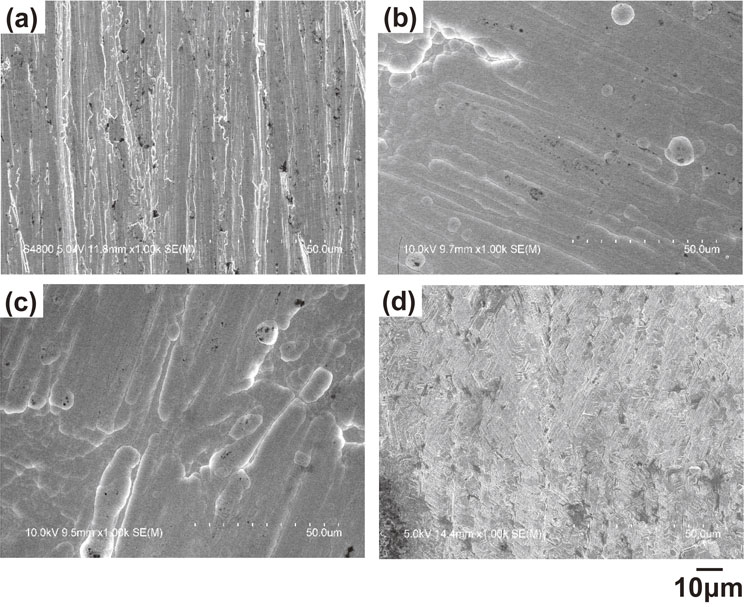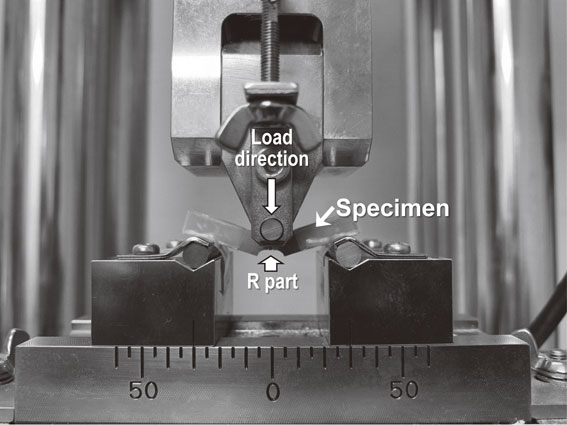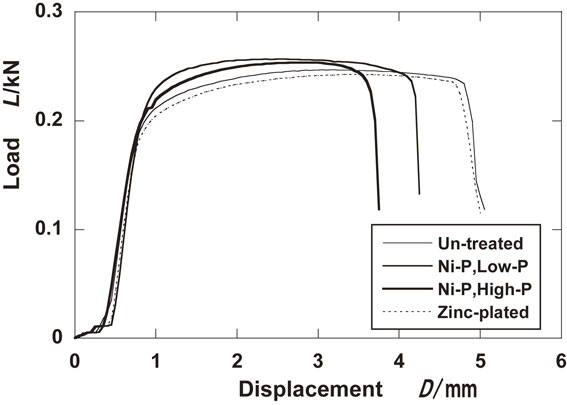2024 年 65 巻 3 号 p. 302-307
2024 年 65 巻 3 号 p. 302-307
In this study, 6061-T6 aluminum alloys were plated with electroless Ni–P with different phosphorus content and three-point bending and rotating bending fatigue tests. The effects of hydrogen due to plating on mechanical properties were investigated. It was shown that the ductility decreased immediately after low-phosphorus type and high-phosphorus type Ni–P plating by three-point bending test because a hydrogen was introduced into the alloys. The fatigue strength of the low-phosphorus type Ni–P plated specimen was higher than that of the un-treated specimen, while that of the high-phosphorus type plated specimen was much lower. It is clear that the fatigue strength differs greatly depending on the phosphorus content in the plating film. 6061-T6 aluminum alloy have been reported to exhibit no hydrogen embrittlement in low strain rate tensile tests under wet condition. However, it was found that hydrogen embrittlement occurred when 6061-T6 aluminum alloy was plated with the high-phosphorus type electroless Ni–P and fatigue-tested on rotating bending machine.
This Paper was Originally Published in Japanese in J. Japan. Inst. Met. Mater. 87 (2023) 114–119.

Fig. 7 Relation between stress amplitude (σa) and number of cycles to failure (N) for the un-treated, Ni–P low-P type-plated, high-P type-plated and zinc plated specimens.
In the field of transportation equipment, including automobiles, it is of importance to reduce the weight of various components to reduce CO2 emissions and achieve a lower fuel consumption toward the government’s goal of carbon neutrality by 2050.1) The aluminum alloy 6061 has good mechanical properties, corrosion resistance, and workability, and is widely used for body panel materials to reduce the weight of automobiles. The alloy 6061-T6 exhibits an excellent hydrogen embrittlement resistance in wet and hydrogen environments2) and has been approved for use in 70-MPa high-pressure hydrogen storage tanks.3)
On the other hand, for 6061-T6 alloys with a low susceptibility to hydrogen embrittlement, mechanical removal of the oxide film in an aqueous solution and introduction of hydrogen enhance the hydrogen embrittlement.4) In addition, hydrogen introduced by an electroless Ni–P plating induced embrittlement in tensile tests under wet conditions.5) However, in the wet environment evaluation, both intrinsic hydrogen from the plating and hydrogen from the environment act, making the route of hydrogen ingress unknown and leading to complex changes in susceptibility to hydrogen embrittlement over time.
In this study, commercially available 6061-T6 alloys were subjected to low-phosphorus and high-phosphorus electroless Ni–P platings, and a high-strength steel was subjected to zinc plating to promote hydrogen embrittlement. Three-point bending and rotating bending fatigue tests were performed under atmospheric conditions. According to the obtained mechanical properties, the potential of the three-point bending test and rotating bending fatigue test as evaluation methods for hydrogen embrittlement of aluminum alloys was analyzed. The mechanism of hydrogen embrittlement is also discussed.
A commercially available 6061-T6 aluminum alloy (hereafter referred to as 6061 alloy), whose chemical composition is shown in Table 1, was used in this experiment. The tensile properties of the 6061 alloy are shown in Table 2. The specimens were fabricated into shapes according to the drawing shown in Fig. 1, and then subjected to testing. Two types of electroless Ni–P plating with different phosphorus contents (hereinafter referred to as Ni–P plating) were performed on the prepared specimens. For the Ni–P plating, commercially available plating solutions (low phosphorus type: KHN-HK, high phosphorus type: KRB-HK, manufactured by C. Uyemura & Co., Ltd.) were employed. For comparison, zinc plating, which exhibits a high susceptibility to hydrogen embrittlement against a high-strength steel, was also evaluated. Table 3 shows the Ni–P plating conditions, while Table 4 shows the zinc plating conditions. The average thickness of the plating film was adjusted to 10 µm. Aluminum alloys form an oxide film immediately. A conventional pretreatment does not provide adhesion of the plating film. Therefore, a double zincate treatment was applied in the plating pretreatment to improve the adhesion of the plating film.6)

Specimen shape (a) For three-point bending test, (b) For rotating bending fatigue test.
The surfaces of the specimens after plating were observed, and three-point bending tests and rotating bending fatigue tests (rotational speed: 3150 rpm (52.5 Hz))7) were conducted on the specimens before and after the surface treatment. In addition, a semiconductor hydrogen sensor gas chromatography-type thermal desorption analysis (TDA) was used to measure hydrogen. The semiconductor hydrogen sensor used for the hydrogen measurement was SGHA-P2 (detection sensitivity: 5 ppb), manufactured by Nissha F.I.S. Co. Ltd., which was capable of measuring hydrogen once in every 2 min. The heating rate was 200°C/h. The sample dimensions were 2 × 2 × 20 mm3.
Figure 2 shows surface SEM images of the un-treated, each Ni–P-plated, and zinc-plated coatings on the 6061 alloy. The un-treated material was lathe-turned, and then polished with Scotch-Brite to suppress the variation in fatigue tests. However, machining scratches from the lathe turning remained on the surface. Smooth films were obtained for both low- and high-phosphorus types of Ni–P plating. The waviness characteristics of the electroless Ni–P plating were also observed. Notably, no effect of the different phosphorus contents in the film on the surface morphology was observed. In the zinc plating, angular electrodeposits were densely deposited.

Secondary electron images showing surface appearance of the three kinds of plating. (a) Un-treated, (b) Electroless-Ni–P-plated (low P), (c) Electroless-Ni–P-plated (high P) and (d) Zinc plated.
Figure 3 shows the results of the thermal desorption H2 analysis (TDA) for the un-treated, low- and high-phosphorus-type Ni–P-plated, and zinc-plated specimens. A hydrogen analysis was performed after three weeks at the end of plating. For the un-treated specimen, the hydrogen release up to 420°C was slight, and the peak from 420°C seemed to correspond to desorption of molecular hydrogen strongly trapped in micropores inside the alloy.8,9) On the other hand, hydrogen release was observed from all plated specimens, which confirms that hydrogen was taken up by the plating. The hydrogen release curves of each plated specimen were different, but those of the low and high-phosphorus types of Ni–P-plated specimens were relatively similar. The hydrogen release peak was observed at approximately 140°C for both low- and high-phosphorus types of Ni–P-plated specimens. The peak at approximately 140°C was attributed to hydrogen in the interstitial space of aluminum.8) The hydrogen release peak based on vacancy–hydrogen clusters at 190–240°C8) suggests that vacancy–hydrogen clusters were also present. The hydrogen release in the zinc-plated specimen was smaller than that in the Ni–P-plated specimens. For the zinc-plated specimen, the peak around 350°C was attributed to hydrogen release from the zinc-plated film.10)

TDA results of various specimens.
In the previous section, we demonstrated that hydrogen was incorporated into the 6061 alloy substrate by various types of plating, and investigated the effect of intrinsic hydrogen on the mechanical properties. Further, three-point bending tests were performed immediately after the Ni–P plating and zinc plating on the 6061 alloy. The three-point bending test for the high-phosphorus-type Ni–P-plated specimen is illustrated in Fig. 4. The specimens were R-machined at the loaded portions to allow stress concentration. The load–displacement curves for each plated specimen obtained by the three-point bending test are shown in Fig. 5. The displacement rate was 0.05 mm/min. The maximum load on the un-treated specimen was 0.246 kN, while the displacement leading to rupture was 4.8 mm.

Appearance of the three-point bending test for the electroless Ni–P (high-P type) plated 6061 aluminum alloy substrate.

Load-displacement curve for various plated specimens.
For the Ni–P plating, the maximum loads for the low- and high-phosphorus types were 0.257 and 0.254 kN, respectively, slightly higher than those for the un-treated specimen. This increase is assumed to be due to the higher hardness of the Ni–P plating film, in accordance with the law of mixture. On the other hand, the displacements leading to fracture of both low- and high-phosphorus types of Ni–P-plated specimens were smaller than that of the un-treated specimen, which indicates an enhanced embrittlement. In particular, the embrittlement of the high-phosphorus type was more pronounced than that of the low-phosphorus type, consistent with the results of hydrogen embrittlement by Ni–P plating on a high-strength steel.11) In the case of Ni–P plating on a high-strength steel, the displacement leading to rupture as well as the rupture stress were decreased.12) On the other hand, for the 6061 alloy, the Ni–P plating decreased the displacement leading to rupture, but slightly increased the maximum load. Thus, the Ni–P plating on the 6061 alloy induced embrittlement but slightly increased the strength against a static loading. Although the 6061 alloy exhibited an excellent resistance to hydrogen embrittlement in SSRT (Slow Strain Rate Tensile) tests under wet conditions,2) the intrinsic hydrogen absorbed into the specimen by the Ni–P plating enhanced the hydrogen embrittlement of the 6061 alloy.
Further, the load–displacement curves of the zinc-plated specimens were almost the same as those of the un-treated specimens, and no effect of the zinc plating on the bending properties in the three-point bending test was observed. According to the same three-point bending test, both maximum load and displacement to failure of the high-strength steel were reduced by the zinc plating, and hydrogen embrittlement was induced.13) These results indicate that hydrogen is supplied in the same manner by the zinc plating, but the action of hydrogen differs depending on the substrate material. Both Ni–P and zinc platings on high-strength steels accelerate the hydrogen embrittlement. However, the Ni–P plating on 6061 alloys promotes hydrogen embrittlement, while the zinc plating does not induce hydrogen embrittlement. These results suggest that the type of plating film is an important factor in hydrogen embrittlement as well as the aforementioned substrate material.
3.4 Evaluation by rotating bending fatigue strengthIn the previous section, the effect of plating on the hydrogen embrittlement of the 6061 alloy was evaluated by three-point bending tests, which showed that the Ni–P plating induced embrittlement of the specimens. Here, we use rotating bending fatigue tests to investigate the effect of hydrogen embrittlement caused by intrinsic hydrogen due to plating.
In rotating bending fatigue tests, the crack generally starts at the periphery and propagates toward the center because the bending stress is maximum at the periphery. Therefore, as the surface morphology of the R part significantly affected the fatigue characteristics, the surface of the R part was observed by SEM after machining to the specimen shape. As shown in Fig. 6, only tool marks attributed to the machining process were observed; almost no other scratches, burrs, etc., were observed.

Secondary electron images of specimen surface as machined at R part. (a) Low magnification (b) High magnification.
Figure 7 shows S–N curves obtained by rotating bending fatigue tests of the un-treated, low- and high-phosphorus-type Ni–P-plated, and zinc-plated specimens. In the low-stress range, the test specimen did not break even after 107 rotations. Therefore, the test was terminated at that point, and the stress amplitude at that time was used for the evaluation of fatigue properties. The fatigue strength of the un-treated specimen was 110 MPa, compared to the tensile strength of the 6061 alloy of 313 MPa. The fatigue strength was 35.1% of the tensile strength. In general, the fatigue ratio of an age-hardening alloy divided by its tensile strength is 0.25.14) The fatigue strength obtained in this experiment exceeded this value.

Relation between stress amplitude (σa) and number of cycles to failure (N) for the un-treated, Ni–P low-P type-plated, high-P type-plated and zinc plated specimens.
Further, regarding the effect of plating on the fatigue strength, the fatigue strength of the low-phosphorus-type Ni–P-plated specimen was 20 MPa higher than that of the un-treated specimen. In the rotating bending fatigue test, the maximum stress occurred at the periphery, and the crack usually propagated from the initiation site at the periphery, leading to fracture. Therefore, a hard film was applied to the surface to inhibit the crack initiation and improve the fatigue strength. The hardness of the low-phosphorus-type Ni–P coating was 670 HV (extremely hard and tough), which suppressed the crack initiation and improved the fatigue strength. On the other hand, the fatigue strength of the high-phosphorus-type Ni–P-plated specimen was 36 MPa, considerably lower than that of the un-treated specimen. The hardness of the high-phosphorus-type Ni–P coating was 550 HV, harder than the 6061 alloy substrate. Therefore, as with the low-phosphorus-type plated specimen, an increase in fatigue strength was expected. However, the fatigue strength decreased significantly. For other alloys, such as alloy 2017, the factor is based on hydrogen absorbed into the substrate by the plating.15,16) According to the hydrogen analysis results in Fig. 3, there is no significant difference in the amount of hydrogen released between the low- and high-phosphorus-type plated specimens, but only the fatigue strength of the high-phosphorus-type plated specimen decreased significantly. This suggests that factors other than hydrogen due to plating may be responsible for the fatigue strength. On the other hand, in the three-point bending test shown in Fig. 5, both low-phosphorus and high-phosphorus-type plated specimens were embrittled. This suggests that the fatigue strength of not only the high-phosphorus-type plated specimen but also the low-phosphorus-type plated specimen may be reduced by hydrogen due to plating in the fatigue test. In the three-point bending test, the embrittlement of the high-phosphorus-type plated specimen was more pronounced than that of the low-phosphorus-type plated specimen. These results were consistent with the lower fatigue strength of the high-phosphorus-type specimen than that of the low-phosphorus-type specimen in the fatigue tests. In the future, baking treatment for hydrogen release will be performed immediately after plating to investigate whether the reduction in fatigue strength is caused by hydrogen from the plating or by other factors.
The fatigue strength of the zinc-plated specimen was slightly lower than that of the un-treated steel, but the effect on the fatigue strength was negligible and in agreement with the results of the three-point bending tests. Zinc plating induces hydrogen embrittlement more than Ni–P plating when the base substrate is a high-strength steel.17) Therefore, as with the high-phosphorus-type Ni–P-plated specimen, a decrease in fatigue strength due to zinc plating was expected, but the effect on the fatigue strength was negligible. These results suggest that the factors of embrittlement based on hydrogen absorbed by the plating are different between aluminum alloys and steel substrates.
Table 5 shows the maximum load and displacement to failure in the three-point bending test and fatigue strength in the rotating bending fatigue test for each plated specimen. In the three-point bending test, the displacement to rupture varied with the type of plating, but the maximum load varied only slightly. On the other hand, in the rotating bending fatigue test, the fatigue strength varied largely depending on the type of plating and, in particular, the fatigue strength of the high-phosphorus-type Ni–P-plated specimen decreased significantly. Thus, by performing rotating bending fatigue tests on un-treated and high-phosphorus-type Ni–P-plated specimens and determining the fatigue strength, it is possible to evaluate hydrogen embrittlement based on internal hydrogen.

The reduction in fatigue strength based on internal hydrogen due to the high-phosphorus-type Ni–P plating on 6061 alloys was similar to those observed for 201716) and 7075 alloys.18) The reduced fatigue strengths of these alloys can be explained by the hydrogen vacancy cluster theory19–21) presented below. The plating produces hydrogen-trapped vacancies. These vacancy-hydrogen clusters migrate due to an external stress, forming voids as the vacancy–hydrogen clusters coalesce. These voids are the initiation points for the rupture. A fracture surface observation also showed voids of several hundred nanometers at the fatigue fracture initiation point.16,18) For the 6061 alloy, if minute voids are formed based on the hydrogen vacancy cluster theory, a static loading, such as that in the three-point bending test, will only reduce the displacement to rupture for the minute defects. However, in fatigue tests, fine defects become a cause of stress concentration and reduce the fatigue strength, which is consistent with the results of this experiment. In addition, the zinc-plated specimen exhibited almost no effect of hydrogen due to plating in both three-point bending test and rotating bending fatigue test, likely as the vacancy–hydrogen clusters permeated the plating film and were released from the substrate before the formation of voids. This result is consistent with the hydrogen desorption behavior of the zinc-plated specimen shown in Fig. 3, where the desorption peak based on vacancy–hydrogen clusters between 190 and 240°C is lower than that of the Ni–P-plated specimen.
Hydrogen embrittlement of commercial 6061-T6 aluminum alloys with electroless Ni–P plating with different phosphorus contents and zinc plating was investigated by three-point bending tests and rotating bending fatigue tests. The hydrogen embrittlement mechanism was discussed. The following conclusions were obtained.
This work was supported by the Light Metal Educational Foundation 2019 integrated advanced research.